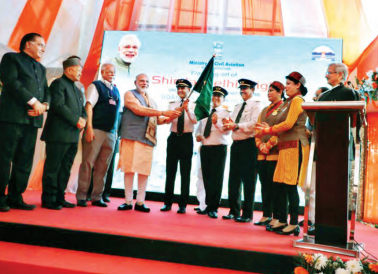UDAN Takes its First Flight
AIBM
July - September 2017

Prime Minister Narendra Modi flagging off the first UDAN flight under RCS in the Shimla-Delhi sector
Prime Minister Narendra Modi flagged off the first flight of the much anticipated Ude Desh Ka Aam Naagrik (UDAN) initiative under the Regional Connectivity Scheme (RCS).
Prime Minister Narendra Modi, on April 27, 2017 flagged off the maiden UDAN flight under RCS. The first flight took off from Jubbarhatti Airport, Shimla to New Delhi. On this occasion, the Prime Minister also flagged off flights in the Kadapa-Hyderabad and Nanded-Hyderabad sectors under the scheme through video conference. The event was held in the presence of Acharya Devvrat, Governor of Himachal Pradesh; Virbhadra Singh, Chief Minister of Himachal Pradesh; P Ashok Gajapathi Raju, Union Minister of Civil Aviation; J P Nadda, Union Minister for Health and Family Welfare; Jayant Sinha, Union Minister of State for Civil Aviation and other dignitaries.
The Delhi-Shimla flight also marks the restarting of operations at the Shimla airport, which has been an un-served airport since 2012 when operating airlines withdrew citing non-viability.
UDAN
On October 2016, the Ministry of Civil Aviation (MoCA) launched the UDAN scheme with the aim to connect currently under-served and un-served airports. Airports Authority of India (AAI) has been implementing this initiative to provide air connectivity to these airports across the country and UDAN is a giant stride in that direction. With more and more citizens taking to flying, the Indian civil aviation market has become one of the fastest growing markets in the world. Thus apart from connecting airports, the UDAN scheme is also expected to cater to a large number of first-tofly customers.
The airfare for a one hour journey of approximately 500 km on a fixed wing aircraft or for a 30 minute journey on a helicopter would be capped at INR 2,500 with proportionate pricing for routes of different stage lengths or flight duration. The selected airline operator would have to provide 50 pc of the flight capacity (subject to a minimum of nine and a maximum of 40) as RCS seats for operations through fixed wing aircraft and a minimum of five and a maximum of 13 RCS seats on the RCS flights for operations through helicopters and will be given three years exclusivity of operations. On RCS route, the minimum frequency would be three and maximum of seven departures per week. To reduce the cost of operations of airlines on flying such routes, a financial stimulus in the form of concessions from central and state government, airport operators and the Viability Gap Funding (VGF) to the interested airlines would be provided to kick-off operations from such airports, so that the passenger fares are kept affordable.









